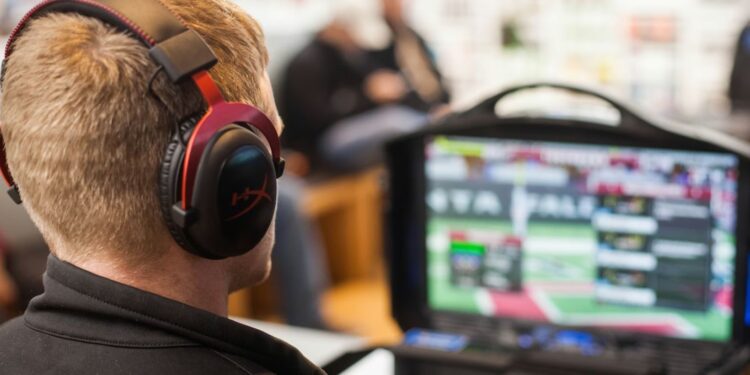Live sports rarely slow down, which is exactly why in-play betting has become one of the most exciting ways to follow a game. Every possession, rally, or breakaway shifts the narrative, and bettors want odds that shift right along with it.
The modern live betting experience feels effortless from the user’s perspective, yet the technology powering those instant updates is surprisingly complex. Behind the interface, a nonstop flow of data, predictive systems, and automated tools work together to keep the odds aligned with what’s happening on the field.
The entire system is built for speed, precision, and fluidity, creating a real-time experience that mirrors the tempo of live sports themselves.
How Live Sports Data Reaches the Platform in Real Time
Real-time data is the foundation of every live odds update, and the path from stadium to screen is built for speed and precision.
Data Captured Within Milliseconds
Live odds begin with one thing: incredibly fast information. An online betting platform depends on ultra-responsive data feeds that capture every detail from a stadium or court within milliseconds.
Providers collect real-time inputs through automated tracking technology and trained observers positioned at events. These streams move faster than most television broadcasts, which typically run several seconds behind the action.
Instant Data Delivery
Instant data transmission is essential for two reasons. It keeps the information displayed to users current, and it ensures that the odds shown reflect the real state of play.
The technology that moves these updates (low-latency APIs, WebSockets, and push-based communication) allows a platform to deliver new information to users the moment something changes. Anyone following in-play wagering on an online betting platform depends on these rapid indicators to keep pace with the unfolding match.
Verification Systems Preserve Accuracy
Accuracy also plays a critical role. Providers use multiple sources and verification steps to detect inconsistencies before they reach the bettor. Slight delays in data can disrupt the flow of live odds, so the systems behind the scenes constantly validate and refresh inputs to maintain a consistent, real-time picture.
These continuous checks allow the platform to present information that reflects what’s happening on the field with dependable clarity. These systems ensure the platform delivers live odds that stay in sync with the pace and detail of the game itself.
How Algorithms Transform Real-Time Data Into Live Odds
Once data reaches the platform, algorithms take over. These systems process enormous amounts of information at remarkable speed. Every new pass, serve, substitution, or play is evaluated alongside historical patterns and predictive insights to establish the likelihood of various outcomes.
Machine learning models run countless micro-simulations per second. They’re built to recognize shifts in momentum, track lineup changes, and interpret sport-specific indicators such as field position or shot efficiency.
When something significant happens, like a goal or a major swing in possession, the algorithms immediately adjust their projections. The resulting live odds update almost instantly on the platform. Alongside these calculations, the system monitors incoming wagers in real time to maintain a steady, informed betting environment.
Human traders oversee the process from a broader perspective, ready to step in for nuanced situations that algorithms may interpret too narrowly. Together, this blend of automated and human reasoning keeps live odds responsive and well-calibrated.
How an Online Betting Platform Delivers Instant Odds Updates
Once the algorithms finalize new probabilities, the platform pushes updated odds to the user interface. This happens in milliseconds. A single play can set off an entire chain of technical events (data collection, algorithm processing, odds recalculation, and interface refresh) before the viewer finishes reacting to the moment themselves.
During pivotal moments, the system may briefly pause certain live markets. This allows the platform to evaluate new data, update its models, and reopen options promptly. Short interruptions create smoother transitions, keeping the betting experience consistent while the platform recalibrates.
Real-time technology also powers the visual side of in-play wagering. Many users follow events through live match centers filled with animations, possession maps, player statistics, and timelines. These features rely on the same data streams that drive live odds, offering bettors a detailed, unfolding view of the match without requiring a broadcast feed.
As the pace of the game rises, the interface mirrors that rhythm, enhancing the sense of immersion.
Why Real-Time Processing Is Essential for Live Odds
Real-time processing shapes the entire live betting experience by keeping every update aligned with the pace of the game:
- Accuracy stays aligned with live action: Fast, detailed inputs ensure the odds match what’s happening in the moment rather than relying on delayed or static information,
- Speed matches the tempo of play: Low-latency systems minimize delays between events and updates, allowing the platform to refresh options quickly after major moments,
- Engagement becomes more immersive: Constant updates turn watching into an interactive experience with micro-betting and next-event opportunities creating continuous moments of involvement.

These elements work together to create a fluid, responsive environment where live odds evolve naturally with the flow of the match.
The Next Chapter in Real-Time Sports Interaction
Real-time technology will continue to influence how fans experience and engage with live sports. As predictive models advance and data pipelines accelerate, live odds will become even smoother and more responsive.
Future interfaces may deliver more personalized displays, expanded micro-wagering opportunities, and richer visualizations that draw bettors deeper into the action. These innovations will bring in-play wagering closer to the pace and energy of the sports themselves, creating an experience that feels immediate and intuitive.
Ongoing improvements in mobile performance will make this level of responsiveness available wherever fans follow the game, turning each moment into a more immersive part of the live sports journey.


























































